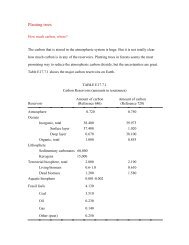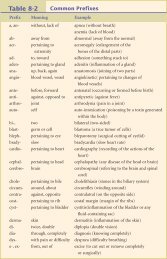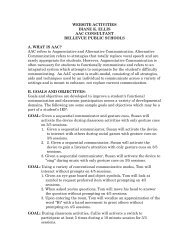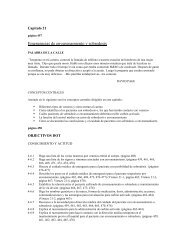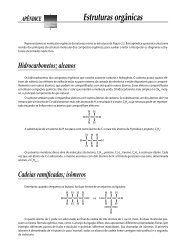chapter
chapter
chapter
Create successful ePaper yourself
Turn your PDF publications into a flip-book with our unique Google optimized e-Paper software.
196 Unit Three Forces Within<br />
South America<br />
Africa<br />
Figure 7.3 This shows the best fit of South America and Africa<br />
along the continental slope at a depth of 500 fathoms (about 900<br />
meters). The areas where continental blocks overlap appear in<br />
brown. (After A. G. Smith, “Continental Drift,” In Understanding<br />
the Earth, edited by I. G. Gass.)<br />
northeastward through the eastern United States and<br />
disappears off the coast of Newfoundland (Figure 7.6A).<br />
Mountains of comparable age and structure are found<br />
in the British Isles and Scandinavia. When these landmasses<br />
are reassembled as in Figure 7.6B, the mountain<br />
chains form a nearly continuous belt. Numerous other<br />
rock structures exist that appear to have formed at the<br />
same time and were subsequently split apart.<br />
Wegener was very satisfied that the similarities in<br />
rock structure on both sides of the Atlantic linked these<br />
landmasses. In his own words, “It is just as if we were<br />
Figure 7.4 Fossils of Mesosaurus have<br />
been found on both sides of the South<br />
Atlantic and nowhere else in the world.<br />
Fossil remains of this and other organisms<br />
on the continents of Africa and South<br />
America appear to link these landmasses<br />
during the late Paleozoic and early<br />
Mesozoic eras.<br />
South America<br />
to refit the torn pieces of a newspaper by matching their<br />
edges and then check whether the lines of print run<br />
smoothly across. If they do, there is nothing left but to<br />
conclude that the pieces were in fact joined in this<br />
way.”*<br />
Evidence: Ancient Climates<br />
Because Alfred Wegener was a meteorologist by training,<br />
he was keenly interested in obtaining paleoclimatic<br />
(ancient climatic) data in support of continental drift.<br />
His efforts were rewarded when he found evidence for<br />
dramatic global climatic changes. For instance, glacial<br />
deposits indicate that near the end of the Paleozoic era<br />
(between 220 million and 300 million years ago), ice<br />
sheets covered extensive areas of the Southern Hemisphere.<br />
Layers of glacial till were found in southern<br />
Africa and South America, as well as in India and Australia.<br />
Below these beds of glacial debris lay striated and<br />
grooved bedrock. In some locations the striations and<br />
grooves indicated that the ice had moved from what is<br />
now the sea onto land. Much of the land area containing<br />
evidence of this late Paleozoic glaciation presently<br />
lies within 30 degrees of the equator in a subtropical or<br />
tropical climate.<br />
Could Earth have gone through a period sufficiently<br />
cold to have generated extensive continental<br />
glaciers in what is presently a tropical region? Wegener<br />
rejected this explanation because, during the late Paleozoic,<br />
large tropical swamps existed in the Northern<br />
Hemisphere. The lush vegetation of these swamps eventually<br />
became the major coal fields of the eastern United<br />
States, Europe, and Siberia.<br />
Fossils from these coal fields indicate that the tree<br />
ferns that produced the coal deposits had large fronds.<br />
*Alfred Wegener, The Origin of Continents and Oceans. Translated from the 4th<br />
revised German edition of 1929 by J. Birman (London: Methuen, 1966).<br />
Africa




